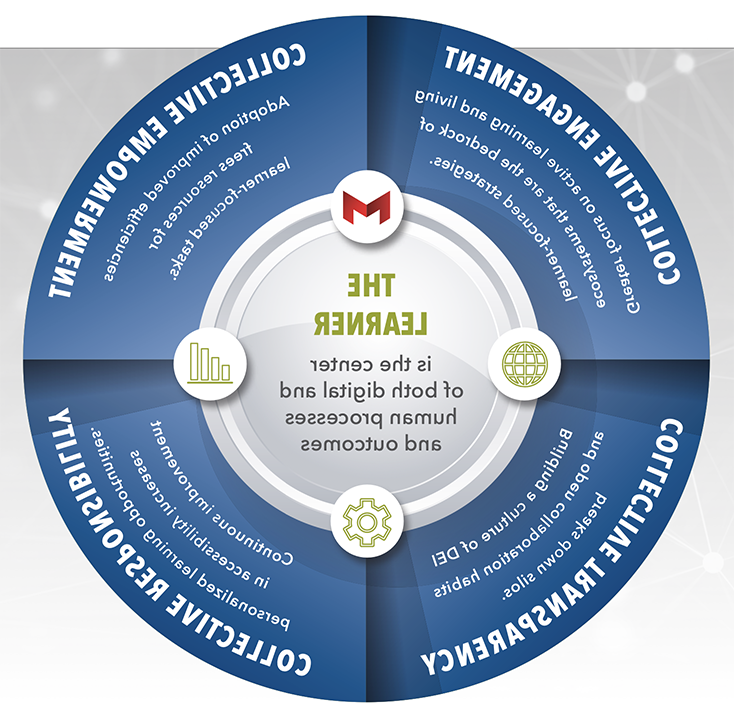Maryville is combining technology and humanology to create the ultimate active learning ecosystem.
As Maryville powers forward with the strategic plan, Maryville 2030 The Access and Opportunity Revolution, 这个计划的“如何”将会发展和演变, centered around a central concept of collective. 简单地说, the success of the plan will be anchored in how Maryville breaks down silos and organizational verticals to promote a culture of 共同的责任 and collective action. 这种转变已经开始.
例如, 2022年底, Maryville dissolved the Information 技术 (IT) Department and installed a matrix called the Digital Learning Experience or DLX. The DLX team is made of a collective group of individuals, 由一个五人小组领导, who implement digital strategies across the University with a student-first mindset. From strategic technology investments to software development to next-generation learning tools and AI, DLX follows a strategic priority matrix to manage projects that have the largest impact on the student journey and experience.
Collective technology refers to the integration and collaboration of various technologies, 包括数字工具, systems and human intelligence (humanology) to collectively address complex problems and achieve common goals. It is a multidisciplinary approach that brings together diverse fields such as AI, 机器学习, 数据分析, 机器人, internet of things (IoT) and person-to person collaboration to create innovative solutions and enhance productivity.
Collective technology emphasizes the importance of cooperation, communication and coordination among different stakeholders, 从人类到机器. The idea is to coordinate the capabilities of each component to solve problems that are beyond the scope of any individual or single technology.
Popular examples of collective technology can include smart cities, 众包, collaborative 机器人 or integrated computer networks. 整体, it is a synergistic approach that combines technology and humanology to address challenges and improve overall efficiency.
建立实践社区
A community of practice (CoP) is a group of people who share common interests or professions and coordinate on exchanging knowledge, ideas and experiences related to their shared domain. CoPs can be formed within already established teams or across different teams within an organization and collaborate both online and offline. cop非正式运作, self-organized social structures that facilitate knowledge and learning among practitioners.
Some characteristics of a community of practice include shared domains, community building and taking on common training and development opportunities. CoPs can take on other various forms like professional associations or online forums.
Maryville目前有5个正在运行的cop, 一个用于Salesforce实现, 松弛的集成, 数据质量, 人工智能的应用和知识文章的构建.
The new infrastructure under the DLX team allows continuous improvement of processes to reduce overall timetables, 比如简化易转请求. 从这里, the success of building power user networks among different departments to help train and solve problems on a day-to-day level provides real-time user feedback. 缔约方会议的结果提高了透明度, scalable progress tracking and University-wide upskilling.

强化勇气文化
就在Salesforce CoP里, there have been 75 power users trained across the University, with more than 15 hours of upskilling provided to each user. 除了, 几乎2,000 badges (or mini certifications) have been completed, which adds to the supply of overall knowledge for the University.
“We have biweekly Salesforce power-user meetings that walk through the platform and set up live demonstrations,Julie Krebel说, director of operations and communication strategy at Maryville. “Each cohort meets on Zoom and can see the platform and ask questions in real time. It’s also a great opportunity to en勇气 Trailhead training courses to keep up with the evolution of the platform so they can customize their experience to their department.”
The values behind Maryville’s CoP infrastructure reinforce a culture of empowerment, 信任, 好奇心和, 最重要的是, 勇气. Combining the forces of technology — by using the most up-to-date digital capabilities and humanology, 与建筑高度协作, interconnected communities — creates the ultimate fertile ground for enhancing the learner journey for Maryville’s students at all levels.
Using CoPs and adopting collective technology aligns with the Maryville 2030 strategic plan by flowing into each of the four main goals that are outlined in the strategy: collective transparency, 共同的责任, collective engagement and collective empowerment. Take a look at the chart above to see how the advantages of both methodologies fit into each.
The use of collective technology and CoPs in higher education can provide a broad range of benefits, 包括增强学习经验, 个性化教育机会, 加强跨学科合作, 改进资源共享, greater accessibility and more efficient administration. Maryville is strategically replacing silos of inefficiency with an integrated set of processes and outcomes that puts the student at the center of a digital universe. 集体观念指导着这项工作.
